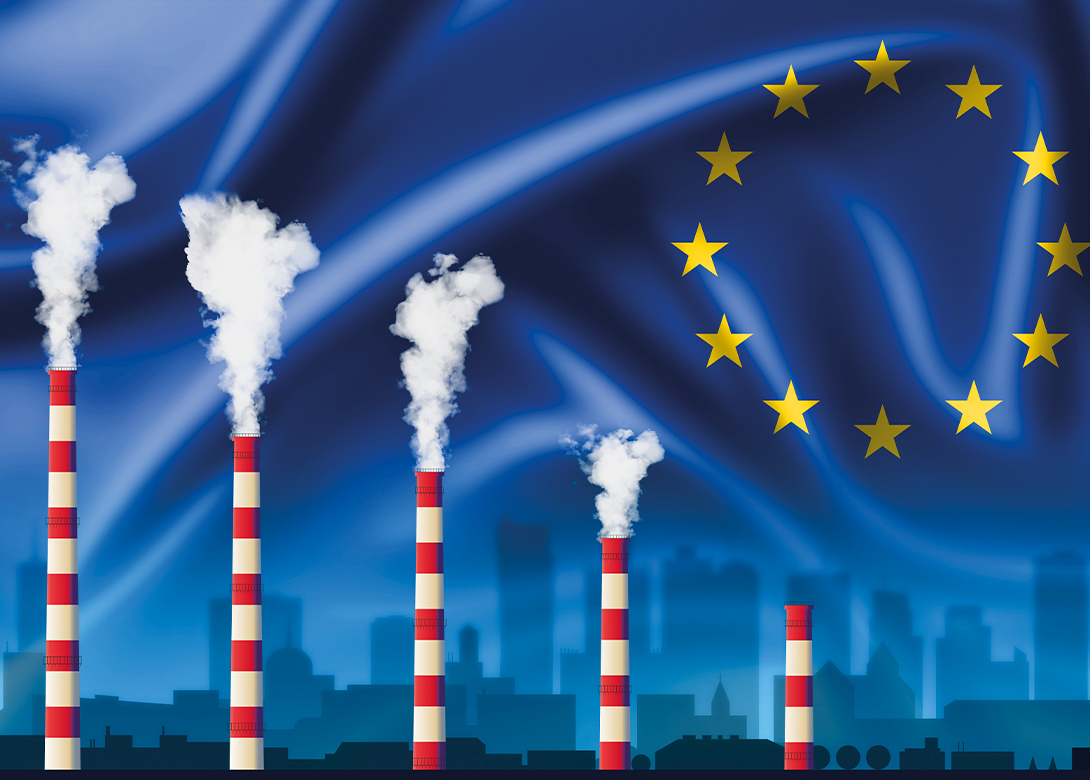
On 7th June the European Fastener Distributor Association (EFDA) held a special webinar for its national member associations, which included a presentation from Andreas Schneider, of StahlmarktConsult, entitled: ‘CBAM and fasteners – what do European importers need to prepare for?’.
With over 70 attendees, from the national member associations, joining the webinar, there was a clear interest in what Andreas Schneider – who has over 30 years of experience as an economist on the steel and raw material markets – had to say about the impact of CBAM.
What is CBAM?
The Carbon Border Adjustment Mechanism (CBAM) has certainty caused a lot of concern within the fastener industry since fasteners were included within the scope of the provisional agreement. The basic approach of CBAM is that when goods from third countries are imported into the EU, they should bear a levy equal to the CO2 costs of EU manufacturers.
Within his presentation, Andreas explained that it has taken a long time for CBAM to be introduced, but the formal adoption by the European Parliament was confirmed on 18th April 2023 and the CBAM regulation was published in the Official Journal on 16th May 2023 (L130/52). The CBAM regulation will concern imports originating from third countries into the EU, with the exception of Iceland, Norway, Liechtenstein and Switzerland. “The decisive factor is the origin of the goods,” highlighted Andreas. “If the goods are produced in third party countries and then exported via Switzerland into the EU, for example, the CBAM obligations will be fully enforced.”
Andreas also pointed out that there is an option in the regulation that in the future, if a third country has a CO2 pricing system that is comparable to the EU system, then that country might be exempted, which could be relevant for the UK. “As far as I know, the UK has only just started consultation in March regarding a similar regulation, so it is unclear whether they would be exempted in the future,” mentioned Andreas.
He also wanted to make it clear that CBAM does not involve all goods, only those listed in Annex 1 of the CBAM regulation. This includes products defined by CN codes of foreign trade statistics, such as cement, electrical energy, fertilsiers, hydrogen, aluminium, iron and steel (except ferro-alloys and scrap), as well as certain products made of iron and steel, including all fasteners (both carbon steel and stainless steel) listed under CN code 7318.
Andreas also made it clear that there is a clear political will within the European Commission to expand the number of goods covered by the regulation in the future, but it would not be before 2026/27.
When will CBAM be implemented?
Next up Andreas explained that CBAM will be implemented in two stages – the transition phase and the implementation phase. “The transition phase is primarily looking to set-up the whole system; to create the necessary authorities; and to start collecting the data – helping make the process clear to all the market participants,” explained Andreas. “The official start of the transition phase is January 2024, but there are some reporting obligations that will relate to Q4 of 2023. However, there will be no financial obligations during this transition phase.”
The full implementation phase of CBAM starts in 2026, at which point companies will need to comply with all obligations regarding registration, reporting and compliance, as they will become compulsory.
What will companies need to do?
Andreas highlighted that importers – who import goods during any given quarter after 1st October 2023 – will need to submit a CBAM report to the European Commission, no later than one month after the end of the quarter in question. “For instance, for the fourth quarter of 2023, importers will need to submit a report no later than 31st January 2024.”
When it came to what needs to be included in the CBAM report, Andreas was clear that it is only parts (a) and (b) that were relevant to the fastener sector. “For the report you need to include part (a), which is the total quantity of each type of goods in tonnes, specified for each installation producing the goods in the country of origin. This means it is not enough to just mention the producer, you need to mention each installation where the goods are produced.”
When asked to clarify what installation meant, Andreas said his understanding was that it would relate to each factory or plant a single company had to produce fasteners. “The term ‘installation’ in the regulation, I believe, relates to every plant/factory where a product is produced. So, if there are several plants on one site then I believe you would have to report data for each plant on that site – not just for the one location – as the emission data for each plant might differ. However, this is not 100% clear and needs to be clarified.”
Another aspect of the report that importers will need to include is part (b), which is the actual total embedded emissions, expressed in tonnes of CO2, per tonne of each type of good.
There are two other aspects of the report that Andreas pointed out do not relate to fastener products. Firstly, the indirect emissions aspect, as there is an exemption for steel products, and the other aspect is carbon price due in the country of origin for the embedded emissions, which doesn’t apply as there is no common carbon price in any country.
How are emissions defined?
When it came to working out how emissions are defined for producing fasteners, Andreas referred to Annex 4 of the CBAM regulation, which says steel and steel products are classed as ‘complex goods’ and for these products emissions are defined as two components – attributed emissions (caused directly by the production process) and embedded emissions (the input materials consumed in the production process).
“For both components, only emissions within the system boundaries are to be considered, which is not so easy to define when it comes to fasteners and the production of steel,” mentioned Andreas. “For example, you have coke, iron ore, and other elements, that go into the production of steel. This is why defining system boundaries of the production process is one of the main tasks of the coming implementing acts, as it is still not clear.”
“For fasteners, the focus will be on the CO2 emissions from the fastener production itself and from the production of steel used for producing the fasteners,” clarified Andreas. “However, there are a lot of detailed questions that have still not been answered, which is why in the CBAM regulation the European Commission has been empowered to adapt implementing acts with further details, especially the information to be reported; the format of the reporting; as well as detailed information of emissions per country and for the different goods.”
He added: “There is still a lot of missing details and a lot of implementing acts that need to be published. Hopefully these will come by Q3 of 2023, but until then there are still many questions that need to be answered or explained.”
What should importers start doing?
Whilst importers have until 2026 before the implementation phase begins, Andreas was clear that companies need to start working on defining roles within businesses when it comes to CBAM, especially with the transition phase starting in the third quarter of 2023. “It is essential that importers define the responsibilities within their company, as there will be several implementing acts with further details being introduced in the coming months,” highlighted Andreas. “These need to be followed closely for any potential impacts on your company.”
He continued: “There also needs to be somebody who takes over the internal coordination and checking of the progress when it comes to CBAM reporting. As of 1st October companies are going to need to record the CBAM related goods they receive, which will need to be divided into CN codes, country of origin and by each manufacturing plant for each supplier. This might not prove easy to begin with, so planning now is essential. You will also need to be in touch with your suppliers and understand what information they already have available regarding their carbon footprint.”
Potential hurdles for companies when it comes to reporting the data is the difficulty in reporting the emissions values. “There is no standard method for calculating the carbon emissions either in the manufacturing of steel or in the manufacturing of fasteners,” explained Andreas. “Therefore, in most cases, there will not be exact data immediately. There will also be large variances between different companies and different factories of individual companies. Another factor is when it comes to the steel for fasteners, this can be made via a blast furnace or electric arc furnace – both routes are possible and the carbon footprint of each differs widely.”
One option that Andreas highlighted is for importers to wait for more implementation acts to be published, as this might provide standard values – making it a lot easier for companies, as they do not need to collect emissions data for each of their products, which could prove extremely time consuming. “The potential issue with waiting for the standard values is how they will be calculated and set,” warned Andreas. “CBAM was planned only for products that are participating in the European Emission Trading System, which is true for steel but not for fasteners. This means all the products already in the European Emission Trading System will have default values, but fasteners will not – so they still need to be established, which will not be an easy task and could lead to inaccurate default values.”
Andreas underlined that if the CBAM regulation is not followed then there are penalties that can be enforced from 2026. “In case of missing, incomplete or incorrect CBAM reports, the importer will be asked to correct them,” mentioned Andreas. “However, if the necessary steps to correct CBAM reports are not taken, or importers have failed to comply with the obligation to submit a report, the competent national authority should impose an ‘effective, proportionate and dissuasive penalty on the importer’. Whilst the amount of fine has not been determined yet, this wording within the regulation would suggest the penalty will not be a small amount.”
Outlook for the implementation phase
For the next part of his presentation Andreas talked through the steps involved during the implementation phase – including becoming a registered and authorised ‘declarant’; the need to purchase CBAM certificates in advance and how they will work; the reporting of CBAM declarations to the CBAM registry; the need to ensure the reported emissions are verified by an accredited verifier; as well as the determination of these emission values and how the preference is for third party manufacturers to register in the CBAM registry – inputting their own verified emissions data, which can then be used by accredited CBAM registrants.
“The full implementation phase may seem far away, but the transition phase starts in October and there will be a lot of implementing acts introduced and details confirmed over the coming months and years, so companies need to focus on this now,” stated Andreas. “CBAM is not just ‘another levy’. It will lead to massive changes in importing for all involved, which is why companies need to start focusing on it today.”
www.efda-fastenerdistributors.org

Will joined Fastener + Fixing Magazine in 2007 and over the last 15 years has experienced every facet of the fastener sector - interviewing key figures within the industry and visiting leading companies and exhibitions around the globe.
Will manages the content strategy across all platforms and is the guardian for the high editorial standards that the Magazine is renowned.
Don't have an account? Sign Up
Signing up to Fastener + Fixing Magazine enables you to manage your account details.